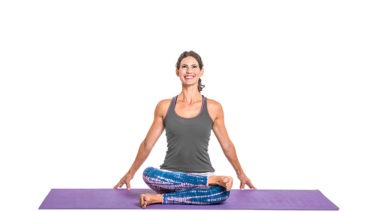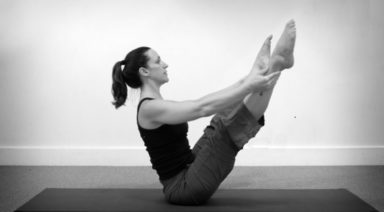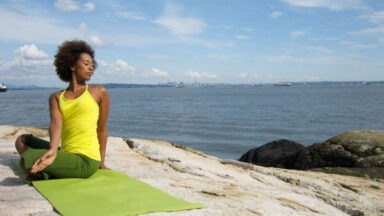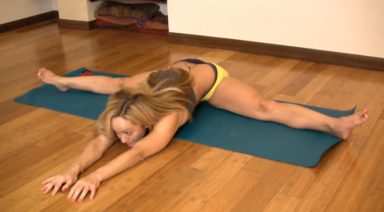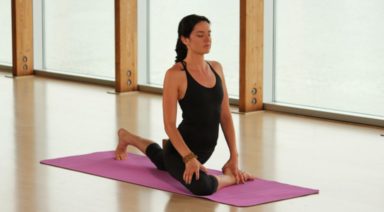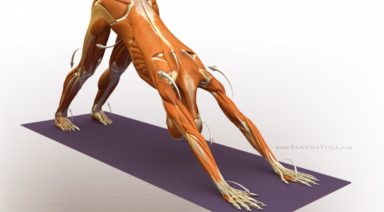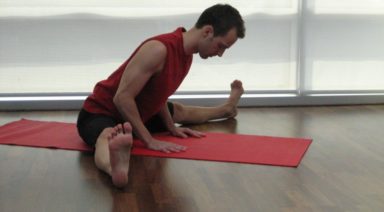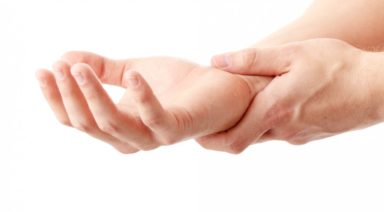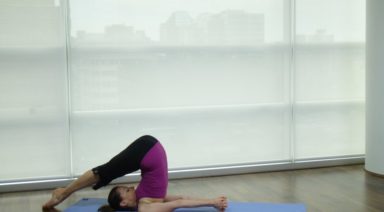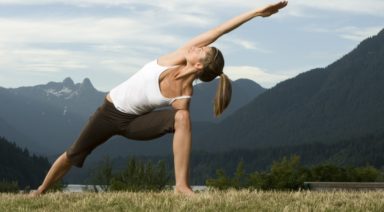Malasana: Squat Pose or Garland Pose

ADJUSTMENTS | BENEFITS | CONTRAINDICATIONS | MANTRA | MUDRA | PREP POSES | SANSKRIT | STEPS | TIPS
A great stretch for ankles and the lower back, Malasana (mahl-AH-sana), which is also referred to as Squat or Garland pose, opens the groin and tones the belly. While comfortable for some, Malasana can be difficult for others. Appropriate adjustments and modifications can help students enjoy the benefits of this posture while strengthening and opening the muscles needed to practice Malasana and other postures.
Philosophy + Origin
There are many beautiful attempts to defend the translation of Malasana as “Garland Pose.” While mala most commonly refers to a garland or rosary, many students have a difficult time understanding how this imagery applies to the pose. Some teachers argue that the shape of the body depicts the bead on a mala, or perhaps the arms look like a mala or garland hanging from the neck. Other teachers will use the story of how this posture is traditionally taken when receiving the gift of a garland from a spiritual teacher. While all very poetic, there’s another lesser-known understanding of Malasana that makes more sense. The word mala can also be translated as excrement. Considering the digestive benefits of this posture, it makes a lot more sense.
ADJUSTMENTS/MODIFICATIONS:
- Place a rolled or folded blanket under the heels if they don’t reach the ground.
- Place a block under your hips to reduce pressure or discomfort in the knees.
- Add a twist or bind to intensify the stretch.
CONTRAINDICATIONS AND CAUTIONS:
- Lower back injury
- Knee injury
TIPS:
When held for longer periods of time, Malasana is a great warm up. If your hips and lower back allow, try beginning your practice with Garland Pose and enjoy the opening and heat created from the posture.
STEP-BY-STEP:
- Begin in a low squat with your feet as close together as possible. If you can, keep your heels on the ground. Use a rolled or folded mat If your heels don’t comfortably touch the floor.
- Spread your thighs wider than your torso so you can lean forward and bring your torso between your thighs. Exhale to deepen into the posture by pressing your elbows against your inner knees or shins. Place palms together in prayer position and create resistance between the inner legs and the elbows.
- Lengthen the front of your torso as you squeeze your inner thighs towards each other. If you want to move deeper, take a twist or a bind. You can also reach back with your hands and hold onto or under your heels.
- Hold the posture for as long as is comfortable, a minimum of 30 seconds. When you’re ready to exit, use an inhale to stand up into Mountain pose, folding forward if you’d like to release the back in Forward Fold.
PREPARATORY POSES:
- Baddha Konasana
- Virasana
FOLLOW-UP POSES:
- Adho Mukha Svanasana
- Uttanasana
SANSKRIT:
- Mala = garland, rosary
- Asana = pose
PHYSICAL BENEFITS:
- Improves digestion
- Stimulates bowel movements
- Stretches groin, lower back, sacrum, hips
- Strengthens and stretches the ankles
- Tones the belly
ENERGETIC BENEFITS:
- Stimulates and strengthens apana vayu
- Grounding
MANTRA:
“Ganesh Mantra”
The grounding quality of Malasana makes it a great pose for learning how to stay rooted to overcome obstacles. The following mantra honors Ganesha, the elephant deity who removes obstacles in our lives. To practice, say or chant, “Om Gum Ganapatayei Namah,” which means, “I bow to the elephant-faced deity [Ganesh] who is capable of removing all obstacles. I pray for blessings and protection.”
MUDRA: Anjali Mudra
Bring your hands together at your heart center as a divine offering to yourself and your teachers.
Legal Disclaimer Before participating in any exercise program or using any fitness products or services that may be described and/or made accessible in or through the Gaia Website and/or the Services, you should consult with a physician or other healthcare provider. Read more about Gaia’s Terms Of Use.
Agnistambhasana: Firelog Pose

ADJUSTMENTS | BENEFITS | SEQUENCING | SANSKRIT | STEPS
Agnistambhasana (AG-nee-stahm-BAHS-ah-nah) is sometimes referred to as double pigeon pose because the legs take a similar shape as they do in pigeon pose. Firelog pose creates a deep stretch in the outer hips and space in the low back.
Philosophy + Origin
Fire (agni) is a transformative element. Agnistambhasana can be very uncomfortable as many people carry deep tension in their hips. See if you can feel the fire building in your hips and with your breath as you hold this pose.
ADJUSTMENTS/MODIFICATIONS:
- Sit on a folded blanket or block to create more space for your hips.
- Place your top leg in front of your bottom leg (rather than on top of it) to ease pressure on the knees.
- Use a block under your top ankle to release pressure on your bottom leg.
- Use a block under your top knee to help the hip relax and to relieve discomfort in the knee.









